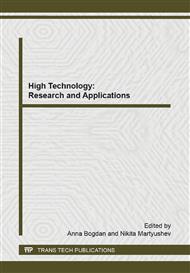[1]
S. Iijima, Helical microtubes of graphitic carbon, Nature 354 (1991) 56-58.
Google Scholar
[2]
M.S. Saha, R.Y. Li, X.H. Sun, High loading and monodispersed Pt nanoparticles on multiwalled carbon nanotubes for high performance proton exchange membrane fuel cells, J. Power Sources. 177, (2008) 314-322.
DOI: 10.1016/j.jpowsour.2007.11.036
Google Scholar
[3]
B. Wu, Y. Kuang, X. Zhang, J. Chen, Noble metal nanoparticles/carbon nanotubes nanohybrids: Synthesis and applications. Nano Today 6 (2011) 75-90.
DOI: 10.1016/j.nantod.2010.12.008
Google Scholar
[4]
A. Esmaeilifar, S. Rowshanzamir, M.H. Eikani, E. Ghazanfari, Synthesis methods of low-Pt-loading electrocatalysts for proton exchange membrane fuel cell systems. Energy 35 (2010) 3941-3957.
DOI: 10.1016/j.energy.2010.06.006
Google Scholar
[5]
K.M. Kaprielova, O.A. Yakovina, I.I. Ovchinnikov, S.V. Koscheev, A.S. Lisitsyn, Preparation of platinum-on-carbon catalysts via hydrolytic deposition: Factors influencing the deposition and catalytic properties, Appl. Catal. A 449 (2012) 203–214.
DOI: 10.1016/j.apcata.2012.10.004
Google Scholar
[6]
K.M. Kaprielova, I.I. Ovchinnikov, O.A. Yakovina, A.S. Lisitsyn. Synthesis of Pt/C Catalysts through Reductive Deposition: Ways of Tuning Catalytic Properties. ChemCatChem 5 (2013) 2015–(2024).
DOI: 10.1002/cctc.201200769
Google Scholar
[7]
K. Elumeeva, M. Shuvaeva, V. Kuznetsov, A. Ischenko, N. Rudina, D.V. Krasnikov, A.N. Shmakov. Pechini Method derived Multi-component Metal Сatalysts for Multi-walled Carbon Nanotube Growth. 11th European Congress on Catalysis – EuropaCat-XI, Lyon, France, September 1-6, (2013).
Google Scholar
[8]
W.A. Spieker, J. Liu, J.T. Miller, A.J. Kropf, J.R. Regalbuto, An EXAFS study of the co-ordination chemistry of hydrogen hexachloroplatinate(IV) 1. Speciation in aqueous solution. Appl. Catal. A 232 (2002) 219-235.
DOI: 10.1016/s0926-860x(02)00116-3
Google Scholar
[9]
M.T. Reetz, M.G. Koch, Water-Soluble Colloidal Adams Catalyst: Preparation and Use in Catalysis. J. Am. Chem. Soc. 121 (1999) 7933-7934.
DOI: 10.1021/ja9906498
Google Scholar
[10]
M.T. Reetz, M. Lopez, Method for in situ immobilization of water-soluble nanodispersed metal oxide colloids. US Patent 7244688 B2 (2007), to Studiengesellschaft Kohle mbH.
Google Scholar
[11]
B. Fang, M. -S. Kim, J.H. Kim, M.Y. Song, Y. -J. Wang, H. Wang, D.P. Wilkinson, J. -S. Yu, High Pt loading on functionalized multiwall carbon nanotubes as a highly efficient cathode electrocatalyst for proton exchange membrane fuel cells. J. Mater. Chem. 21 (2011).
DOI: 10.1039/c1jm10847f
Google Scholar
[12]
I. Kvande, J. Zhu, T. -J. Zhao, N. Hammer, M. Ronning, S. Raaen, J.C. Walmsley, D. Chen, Importance of Oxygen-Free Edge and Defect Sites for the Immobilization of Colloidal Pt Oxide Particles with Implications for the Preparation of CNF-Supported Catalysts. J. Phys. Chem. C 114 (2010).
DOI: 10.1021/jp906572z
Google Scholar
[13]
T. Onoe, S. Iwamoto, M. Inoue. Synthesis and activity of the Pt catalyst supported on CNT. Catal. Commun. 8 (2007) 701–706.
DOI: 10.1016/j.catcom.2006.08.018
Google Scholar


